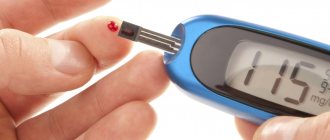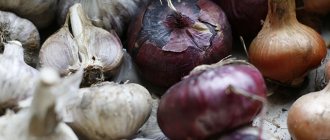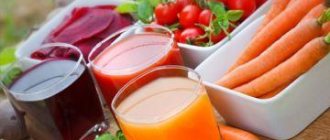General rules of nutrition for diabetes
Currently, diabetes is a global problem. Over the past ten years, the number of people suffering from diabetes has more than doubled and reached 425 million. According to forecasts, by 2045 their number could reach 629 million.
Diabetes
is a group of endocrine diseases associated with impaired glucose absorption and developing as a result of an absolute or relative deficiency of the hormone insulin, resulting in the development of hyperglycemia - a persistent increase in blood glucose levels. This disease is characterized by a chronic course, as well as a violation of all types of metabolism due to a violation of carbohydrate metabolism; fat, protein, mineral and water-salt metabolism are also disturbed.
Let's look at the reasons for the development of this disease. Type 1 diabetes is characterized by the destruction or destruction of pancreatic cells. This usually leads to absolute insulin deficiency. The development of type 1 diabetes involves both genetic and environmental factors - viral infections, nutrition, toxins, hygiene. Type 2 diabetes mellitus is characterized by the development of insulin resistance and relative, rather than absolute, insulin deficiency and is manifested by persistent hyperglycemia. The main problem with any type of diabetes is an increase in blood glucose levels and carbohydrate starvation of cells, since glucose cannot enter it, but floats idle in the blood.
The treatment of diabetes mellitus is based on diet therapy. The general principles of nutrition, regardless of the type of diabetes, are that the patient is advised to reduce the carbohydrate load in the diet to 5-7% and increase the consumption of vegetable fats. Previously, diabetics were recommended to completely eliminate simple carbohydrates, but today there is an increasing emphasis on personalized diets with an individual selection of food baskets and calorie calculations. Currently, the slogan is very popular: “With diabetes there are no restrictions, there is only the right lifestyle.”
The diet for patients with diabetes is based on the glycemic index. Essentially, this index reflects the speed at which sugar from them is absorbed into the blood. Products with a high index - jam, cookies, cakes - have a high absorption rate. Products with a low index - cereals, fruits - have a lower index. The slower the absorption rate, the easier it is for the pancreas to cope with the load. Thus, foods with a GI of up to 55 are broken down gradually and almost do not cause an increase in sugar.
Also, do not forget about the insulin index of foods, which reflects the amount of insulin rise in response to food consumption. The insulin index of foods is important to take into account for people with diabetes to predict the body's reaction when consuming specific foods and to correctly calculate the doses of insulin preparations (short and long-acting) that will be used for injection after meals.
Any meal, even protein, provokes a large release of the hormone insulin. And the more insulin swings you have during the day, the more likely you are to develop insulin resistance, which will subsequently lead to type 2 diabetes. Everyone’s favorite snack options in the form of dairy and fermented milk products, such as cottage cheese, kefir and yoghurt, have a very, very high insulin index, which means that the insulin swing will swing very strongly along with your mood and irritability.
Let's consider different options and features of diets depending on the type of diabetes.
Basic nutrition rules for type 1 diabetes
In the first type, patients are completely dependent on insulin injections, and the diet is designed taking into account its administration. Diabetics need to study the presence of carbohydrates (bread units) in foods to determine the dose of the hormone that will help absorb them. A bread unit is a conventional concept that implies a certain amount of any product containing 12 grams of carbohydrates. It is recommended to consume no more than 12 bread units per day. Insulin is administered half an hour before meals, so it is important to know exactly what will be eaten and in what quantity to absorb the carbohydrates in the food. For each main meal you need to eat no more than 5-6 bread units and 2-3 for an additional one.
You should almost completely avoid foods containing easily digestible (simple) carbohydrates. These are sweets, jam, condensed milk, marshmallows, marmalade, halva, cakes, jam, etc., as well as oatmeal and semolina porridge, mashed potatoes. Reducing the amount of carbohydrates in your diet, which raise blood sugar, reduces the need for medications. Consuming the same dosages as before switching to a low-carbohydrate diet may cause hypoglycemia. It is necessary to measure your blood sugar regularly while starting this diet and adjust your medication dosage accordingly.
Daily caloric intake is distributed throughout the day into 4-5 meals. According to the BJU ratio, the distribution looks like this: proteins make up 20-25% of the total diet, fats - 30%, of which saturated no more than 10%, carbohydrates 45-50%.
Basic nutrition rules for type 2 diabetes
More serious restrictions are needed for non-insulin dependent variants of the disease. This is due to the fact that this form usually appears against a background of obesity, and not only high levels of glucose, but also insulin are found in the blood. However, it very often happens that insulin resistance, which can subsequently lead to type 2 diabetes, does not manifest itself for a very long time, and even people with insulin resistance are not always overweight, but the level of glucose in the blood is constantly high and This situation leads to very sad consequences. Dietary nutrition for type 2 diabetes helps restore cells' ability to absorb sugar and helps restore cell sensitivity to insulin.
Type 2 diabetes mellitus is primarily a disorder of carbohydrate metabolism. But at the same time, other types of metabolism suffer - lipid, protein, mineral. Treatment for type 2 diabetes mellitus includes diet, moderate exercise, stress management, and medications (diabetic drugs).
The diet for type 2 diabetes is based on key principles
:
- Abundance of vegetables
- The amount of vegetables consumed may depend on age, gender and frequency of exercise per week. As a general rule, women who exercise up to 30 minutes daily are advised to consume at least 500 grams of vegetables daily. For more intense exercise, it is recommended to increase the amount of vegetables to 800 grams. For men, the recommended amount of vegetables is 600 and 1000 grams, respectively.
- Unsaturated fats
— the presence of an adequate amount of polyunsaturated and monounsaturated fats in the diet allows you to maintain cholesterol levels within normal limits and reduces the risk of developing cardiovascular diseases, one of the most common long-term complications of diabetes. Unsaturated fats are found in many foods, including nuts, avocados, fatty sea fish, and olive oil.
- Avoid processed foods
— nutritionists and doctors agree that avoiding processed foods has a positive effect on health. Due to substances that are added to ensure a long shelf life, processed foods tend to have a high glycemic index. Regular consumption of such foods can negatively affect the health of a diabetic.
We recommend
“Products to increase hemoglobin: diet and dietary features” Read more
Basic principles of nutrition
The goal of a diet for diabetes is to normalize carbohydrate metabolism, as well as to prevent disorders of fat metabolism.
The treatment table according to Pevzner corresponds to No. 9.
General characteristics of dietary nutrition for the day:
- carbohydrates due to polysaccharides should be 300-350 grams;
- proteins - at least 90-100 grams, of which 55% animal proteins;
- fat - at least 70-80 grams, of which 30% vegetable fats;
- free liquid - 1.5 liters (including soups);
- energy value - 2300-2500 kilocalories.
Basic principles of the diet:
- diet; Meals for diabetes should be fractional: in small portions up to 5-6 times a day, which, on the one hand, will prevent the feeling of hunger, and on the other hand, will eliminate overeating.
- temperature regime; Food should be consumed heated to 15-65 degrees Celsius.
- alcohol consumption; When following a diet for diabetes, you should avoid alcoholic beverages, as they contain a large amount of easily digestible carbohydrates.
- limiting sugar; Sugar and “fast” carbohydrates should be replaced with xylitol due to the fact that they are quickly digested and threaten coma.
- salt restriction; A diet for diabetes involves limiting table salt, as it has an adverse effect on the kidneys.
- nutritional content; The amount of proteins, fats and carbohydrates must be balanced: at each meal, their content should be approximately the same.
- compulsory breakfast; In the morning, before the insulin injection, you need to have a snack so as not to cause a hypoglycemic coma.
- culinary processing; It is necessary to avoid eating fried foods; all dishes are served boiled and baked to spare the liver.
- drinking fluids; In diabetes mellitus, both excess and lack of fluid is dangerous for the development of coma. The amount of liquid you drink should be at least 1.5 liters per day.
Healthy foods for diabetes
- Green leafy vegetables
Spinach, cabbage and bok choy are low in calories but rich in nutrients such as vitamin C, beta-carotene and magnesium, which help prevent diabetes. One serving (about 106 g) per day reduces the risk of developing type 2 diabetes by 14%.
- Legumes
These fiber-rich foods can help stabilize your blood sugar levels. Legumes are low in saturated fat, which can be bad for your heart.
- Fish
Omega-3 fatty acids are great helpers in preventing diabetes and reducing the risk of cardiovascular diseases. Omega 3 is needed by the body for the synthesis of red blood cells and cell membranes, they help in the body’s absorption of other vitamins, and most importantly, they suppress chronic inflammation, which is a sure companion of insulin resistance.
- Olive oil
A staple of the Mediterranean diet, it is important for heart health as it is filled with monounsaturated fatty acids. These fats (also found in large quantities in nuts) are important in preventing diabetes by helping the body effectively control blood sugar levels.
- Nuts
As a source of monounsaturated fatty acids, nuts are rich in magnesium, another important nutrient. Global research shows that people who regularly eat nuts have lower rates of diabetes.
- Citrus
All citrus fruits contain antioxidants - great helpers in maintaining the balance of insulin in the blood.
- Whole grains
Eating whole grain bread, quinoa and brown rice reduces the risk of developing diabetes. Whole grains are rich in fiber, which helps the body control blood sugar levels. Complex carbohydrates are a kind of buffer that protects us from high rises in blood glucose, so if you want to eat a product with a high glycemic index, combine it with complex carbohydrates.
- Cinnamon
The tasty spice helps the body regulate insulin levels. Cinnamon is a kind of insulin sensitizer, that is, it helps improve cell sensitivity to insulin. The spice helps with hypertension (chronically high blood pressure), reduces the concentration of sugar in the blood when used systematically in the required dosages, improves overall well-being, and has a positive effect on metabolic processes.
- Ginger
It is a catalyst for metabolic processes, reduces sugar levels, cholesterol and blood clotting indicators. Recommended for daily consumption fresh as a seasoning or base for tea.
What foods can and cannot be eaten with diabetes: details about carbohydrates
Carbohydrates are the main source of fat. That is why they are included in the diet with caution. But this is not a reason to replace these substances with proteins or fats - our body needs them for health and normal functioning.
When creating a new diet, it is advisable to exclude fast carbohydrates and prefer slow ones. The former are found in the following products:
- Sweets.
- Bakery products.
- Pasta.
- Starch.
- Potato.
- Fast food.
- Fast food.
- Cookie.
Simple carbohydrates are prohibited, but complex carbohydrates found in vegetables are not. So switch to plant-based foods - it will help you stay healthy and energetic.
Ideal for diet:
- Cabbage (broccoli, Brussels sprouts, cauliflower, white cabbage).
- Laminaria (sea kale).
- Tomatoes (in limited quantities).
- Raw onions or green onions in salads.
- Mushrooms.
- Beans in pods.
- Various greens.
- Cucumbers.
- Celery.
- Patissons.
- Eggplant.
Prohibited foods for diabetes
Today, doctors try not to strictly limit patients with diabetes and not to force them into strict limits regarding permitted and prohibited foods. Even with type 2 diabetes, in which diet plays a role, you can eat a varied diet, but there are a number of foods that people suffering from this disease will still have to remove from the diet. In fact, the list below is recommended for anyone who cares about their health to exclude from their diet.
- Sweet
The black list includes sugar and all products containing it in excess. We must forget about ice cream, chocolate, marmalade, jam, sweets, preserves, halva and other sweets.
- Bakery
Sweet bakery products are prohibited: muffins, cookies, buns, white loaf and bread.
- Fatty foods
These dishes can greatly increase your glucose levels. For this reason, a diabetic should avoid duck, pork, lamb, lard, mayonnaise, and cream. It is also recommended to exclude sweet yogurt, fatty cottage cheese and cheese.
- Semi-finished products
They contain a large number of flavorings, stabilizers, and flavor enhancers. You should not eat fish sticks, ready-made industrial cutlets, dumplings, sausages, and sausages.
- Trans fats
Their consumption will harm not only a diabetic, but also a healthy person. Prohibited products include margarine, confectionery fat, spread, French fries, hot dogs, and burgers.
- Fruits
It is not recommended to consume certain fruits and dried fruits that cause a strong increase in blood sugar. Among them are dried apricots, dates, figs, raisins, persimmons, melon, grapes, bananas.
What foods increase blood sugar: list of prohibited foods for diabetes
- Sweets, honey, confectionery products made from puff pastry and refined white flour - it is recommended to find a healthy alternative for them - stevia-based treats in moderation.
- Pastries and bread made from white flour are prohibited. It can be replaced with rye or bran, but in this case the daily requirement will be approximately 325 g.
- Salted and pickled vegetables and potatoes are excluded from the diet.
- All store-bought sauces are high in sugar, preservatives, fat, pepper and salt.
- Sweet fruits and berries, freshly squeezed juices.
- Whole and skim milk, condensed milk.
- Various types of canned food, instant food, packaged snacks.
- Syrups (maple, corn) and other easily digestible carbohydrates.
- Fatty meats and fish, lard, smoked meats.
- Any soups containing potatoes and rice, in fatty and strong broths.
It is also necessary to completely exclude from your diet foods containing dangerous trans fats:
- Margarine.
- Spread
- Fast food.
- Cookie.
- Cakes.
- Chips.
- Mayonnaise.
- Semi-finished products.
Here are the foods you need to exclude if you have diabetes - check out the list of prohibited foods to easily create the right menu. Diet is the main means of eliminating the symptoms of the disease and allowing you to stay in good shape.
We remind you that everything that is on the “black list” must be excluded from your diet forever - eat right and you will not have to deal with the consequences of your own weakness. If you look closely at the foods that are allowed, you will see the ingredients for a varied, tasty and filling diet. This:
- Lean meat, poultry, fish.
- Eggs, seaweed.
- Various seafood.
- Butter (butter, vegetable), cheese.
- Mushrooms.
- Some cereals, fruits, berries.
- Vegetables are mostly green.
Table No. 9 for diabetes
This diet was developed by the Soviet scientist M. Pevzner specifically for diabetics and has long been used in treatment both in hospital and at home. Table No. 9 includes
:
- 300 g of fruit;
- 80 g vegetables;
- 100 g mushrooms;
- 1 tbsp. natural fruit juice;
- 300 g of meat or fish;
- 200 g low-fat cottage cheese, 500 ml fermented milk products;
- 100-200 g of bran, rye, wheat bread mixed with rye flour or 200 g of cereals (ready-made), potatoes;
- 40-60 g fat.
Main dishes
Soups
: vegetable, cabbage soup, beetroot soup, borscht, vegetable and meat okroshka, fish or light meat broth, mushroom soup with cereals and vegetables.
Poultry, meat
: rabbit, veal, chicken, stewed, chopped, boiled, turkey.
Fish
: pike perch, navaga, cod, pike and lean seafood, stewed, steamed, boiled, baked in juice.
Snacks
: vegetable mix, vinaigrette, jellied dietary fish and meat, vegetable caviar, unsalted cheese, seafood salad with butter.
Sweets
: desserts made from berries, fresh fruits, berry mousses, sugar-free fruit jelly, sugar-free jam and marmalade.
Egg dishes
: soft-boiled eggs, egg white omelet, in dishes.
Other Diet Strategies for Diabetes
Of course, we should not forget that all diets are compiled strictly individually, taking into account the age and gender of the patient, and his level of physical activity.
Thus, today there are several options for dietary strategies for diabetes. If it is necessary to normalize body weight in a patient with type 2 diabetes mellitus, the Mediterranean diet
, which is based on daily physical activity.
The basic principles of the diet are
:
- fractional meals 5 times a day - 3 main meals and 2 snacks;
- breakfast should be more carbohydrate-rich, mainly consisting of complex carbohydrates;
- light dinner consisting of lean protein and vegetables;
- During the day you need to consume more than 1 kg of various vegetables and herbs;
- It is important to maintain a drinking regime - at least 7-8 glasses of water per day.
The main sources of fat in the diet are
– unrefined olive oil, sometimes you can use sesame, rapeseed, and peanut. Animal fats are limited on the Mediterranean diet.
Particular attention is paid to Omega 3 fatty acids and oleic acid, found in oils, fatty fish and seafood. These fatty acids have a huge impact on the prevention of atherosclerosis, improve insulin sensitivity, and help immune cells detect inflammation and suppress it.
Carbohydrates on the Mediterranean diet are predominantly complex with a low glycemic index - durum wheat pasta, beans, rice, lentils, coarse bread, seasonal vegetables and fruits.
Protein is presented in the form of low-fat soft cheeses, eggs, fish, seafood and rarely poultry.
Another diet option for diabetes is the LCHF
and keto diet
. The essence of this dietary strategy is to consume low amounts of carbohydrates and high amounts of fat. Carbohydrates on fatty diets are limited to 50 grams per day, and on a keto diet the restriction is even more serious - no more than 10 grams of carbohydrates.
The following foods are completely excluded on the keto diet:
:
- sugar, honey, artificial sweeteners;
- sweet carbonated drinks;
- yeast bread, pastries;
- cereals, porridges, flakes and breakfast cereals;
- skim milk, kefir, yoghurts;
- sweet curds;
- margarine.
We recommend
“Iron in foods: beneficial properties and effects on the body” Read more
In the concept of the LCHF diet, insulin is a dangerous thing, because after we eat something high in carbohydrates, the carbohydrates are broken down into glucose, the blood sugar level begins to rise sharply, and accordingly the insulin level increases greatly in order to transport glucose to the muscles, liver and fat cells, that is, insulin is “responsible for our obesity.” Moreover, protein can increase insulin levels just as well as carbohydrates. And fats do not raise insulin at all, which is good for insulin resistance and, if necessary, to improve the sensitivity of cells to insulin.
Who's at risk
The development of diabetes is promoted by:
- Stressful situations, neuroses.
- Poor or excessive, irregular nutrition.
- Incorrect diet (with a predominance of fatty, fried, sweets, flour, fast food).
- Bad ecology.
- Sedentary lifestyle.
Physical inactivity leads to the accumulation of fatty deposits, which gradually turn into adipose tissue. The latter eventually loses sensitivity to insulin, the hormone that controls blood sugar levels. It starts to grow and diabetes develops.
That is why obese people are most susceptible to this disease. In addition, do not forget about hereditary predisposition.
To identify the disease in the early stages or prevent its development, you need to consult a doctor in time. To do this, you need to assess whether you are at risk. Listen to your body. If alarming symptoms have been haunting you for more than a day, make an appointment with a specialist and take a blood test to check the glucose content.
Following simple rules will help you avoid prediabetes:
- Adjustment of the daily routine - proper sleep, mandatory physical activity.
- Changing the diet - excluding fatty, fried, sweets, pickles, smoked foods, and semi-finished products from the menu.
Diabetes mellitus in children
Diabetes mellitus in children can be caused by hereditary predisposition, poor diet, including consumption of excessive amounts of simple carbohydrates and sweets, and the disease can also occur as a result of mental or physical trauma. Treatment of diabetes in children, as well as in adults, consists of a therapeutic diet and the administration of insulin for type 1 diabetes.
The diet of children with diabetes should be rich in vegetables such as white and cauliflower, onions, spinach, and garlic. You can eat unsweetened fruits, meat, poultry, and fish. It is advisable to give milk and cottage cheese those that have a small percentage of fat content, provided that the child does not have intolerance to cow's milk protein. When cooking meat or fish, you can use spices to promote better protein absorption.
All confectionery products, sweets, grapes, apricots, rice, baked goods, cookies, and plums should be excluded. Parents of a child with diabetes need to learn how to calculate the consumption of bread units when feeding the child, and calculate the required dose of insulin. The child himself also needs to be taught these skills as early as possible.
Daily diet from Elena Malysheva
Elena Malysheva has been broadcasting about health for a long time and knows everything about the diet for type 2 diabetes. A diabetic should have breakfast before 8 am. It is better to start the day with oatmeal, and not with milk, but steamed with boiling water. You can use kefir or low-fat cottage cheese with porridge. 2 hours after breakfast, it is recommended to have a snack of boiled vegetables or unsweetened fruits. You should start having lunch no later than 12 noon. The menu includes boiled fish or meat and a salad of fresh vegetables without spicy seasonings and with a minimum amount of salt.
If desired, you can add 1-2 tablespoons of olive oil to fish or meat. The afternoon snack should be light, consisting of a glass of milk or kefir without sugar or sweeteners. Dinner must take place no later than 19:00. It is best not to load your stomach with heavy meals and eat some vegetables or fruits.
By following dietary instructions and advice, a diabetic will be able to return to normal life in a short time, while preventing the development of complications from diabetes.











